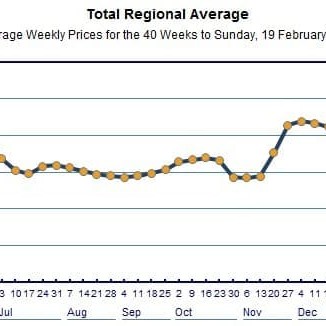 Diesel fuel prices in country and regional areas of Australia have stabilised at a national average pump price of around 152c/litre since December, recent industry data shows.
Diesel fuel prices in country and regional areas of Australia have stabilised at a national average pump price of around 152c/litre since December, recent industry data shows.
Information released by the Australian Institute of Petroleum (see graph) shows prices are currently about 2c/l higher in country areas than where they were in early November last year, but a little softer than where they sat this time a month ago.
International oil markets began the New Year confronting a host of supply issues, not the least being current political instability in Syria and Iran, on top of earlier retaliatory threats from Tehran to close the Strait of Hormuz, through which flows about one-third of world oil exports.
Oil prices jumped $4-$5/barrel on the January reports, but have since eased on mounting European debt issues.
Global oil demand growth for 2012 has now been trimmed by 1.1 million barrels, down about 11pc from earlier estimates, due to ongoing global economic weakness. This should help offset some supply issues caused by Middle Eastern political unrest.
The AIP diesel price report for the week ending February 19 showed a national average retail diesel price in rural and regional (non-metropolitan) areas of Australia of 151.6c/litre, down 0.2pc from the same time last month.
The price is calculated as a weighted average of retail diesel fuel prices for country regions in each State/Territory. All values are in cents per litre and include GST.
Prices eased slightly across most State and Territory regional/country areas in February, with WA and SA recording to biggest declines compared with the same time in January.
Regional diesel prices in the recent AIP report included:
- Victoria 149.2c/l (down 0.1c on January)
- NSW 151.3c (down 0.2c)
- Queensland 151.1c (down 0.3c)
- WA 155.6c (down 0.4c)
- SA 150.5c (down 0.4c)
- TAS 154c (up 0.2c), and
- NT 164.6c (unchanged).
As the graph shows, national prices reached a high-point around 155c/l in May last year, before easing from June. This was around the time the A$ value softened off extreme levels above US109c and the second wave of concern emerged about the global economy.
Since then, prices flat-lined through to November, but then started to climb.
Variation in diesel prices can have a considerable impact of cost of production across the Australian beef industry, impacting on livestock transport, cost of shipping in live export, pumping stock water and providing station electricity in remote locations.
Crude oil, diesel and petrol prices are closely linked, as the price of crude oil accounts for the majority of the cost of producing a litre of petrol or diesel. Crude oil is purchased in US$, meaning that changes in the value of the A$ against the US currency have a direct impact on the relative price of crude oil in A$ terms.
Australia is only about 40pc self-sufficient in transport fuels, meaning international market trends have a direct impact on local pricing.
During the global financial crisis, crude oil hit highs of US$160 per barrel, increasing fuel costs to an average of almost 50pc of total revenue for road freight transport companies, analyst IbisWorld said in a recent report.
Although oil prices have since moderated, the price is still considerable at about US$100 per barrel and is expected to rise over the coming years.
- Click on the image here for a better view of recent regional Australian diesel price trends.
